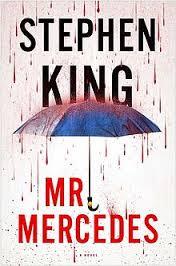 King, Stephen. Mr. Mercedes
King, Stephen. Mr. Mercedes
New York: Scribner, 2014
448 pages
ISBN–13: 978–1476754451
I don’t read a lot of Stephen King’s works because I don’t like horror. But I do love mysteries, so when I saw King’s latest book described as a “straight-up mystery,” I went for it.
Technically, Mr. Mercedes is not a mystery—in which the reader tries to decipher clues along with the detective and finds out the killer’s identity at the end—but a thriller—in which the reader knows the killer’s identity early on and watches the killer and the detective play cat and mouse throughout the story. But the book is a straight-up thriller, and it builds suspense by building engaging and credible characters.
King opens the book with a scene of hundreds of unemployed people lining up in the pre-dawn hours before the opening of a job fare. This introductory narration focuses on three people, a young man and the single mother with an infant whom he befriends. In this short introduction we become emotionally invested in these characters, so when the big silver Mercedes plows into the crowd, we want to know how and why. And we want to see this killer caught and punished.
The story then cuts to Bill Hodges, a police detective who had been unable to solve the case of the Mercedes killer before he retired. Now he spends his time drinking while watching afternoon talk shows on TV and playing with the service weapon of his late father, also a police officer. But when he receives a taunting letter from someone calling himself the Mercedes killer, Hodges finds renewed purpose. He begins to use his old investigative strategies to identify and catch this maniac on his own.
Next we meet Brady Hartsfield, the villain, and overhear his thoughts about why he killed all those people and why he wrote to Bill Hodges. We gradually learn more about him as we follow his twisted logic and see how he keeps his inner life under cover while moving through his everyday existence of holding down two jobs and caring for his alcoholic mother.
Both Hodges and Hartsfield could be only mildly interesting stereotypes. Hodges is the retired policeman, the adrenaline junkie, who’s having trouble adjusting to the dull life of retirement and who is haunted by his failure to solve one of the biggest cases of his career. Like many police officers, his job was his whole life. He has drifted away from his only family, a daughter, and feels lonely and worthless. And Hartsfield could be the typical psychopath of literature, with a now alcoholic mother who was widowed young and has lavished sexually inappropriate behavior on her son. He avoids personal relationships with coworkers and spends all of his free time in the computer center he has created in his basement.
But the devil, as they say, is in the details, and Stephen King is a master of detail. His development of both Hodges and Hartsfield is so specific and complex that we come to understand both of these characters as they play out their mutually driven scenario of action and counteraction.
And just as King uses minor characters in the opening scene to draw us into the world of the novel, he provides a few more along the way to advance the plot and to retain our sympathy. There’s 17-year-old Jerome Robinson, Hodges’s neighbor and only real friend, who provides both the computer savvy and the moral support Hodges needs in his investigation. There’s Janey Patterson, sister of the owner of the stolen Mercedes used in the job-fair killings, who also contributes to both Hodges’s investigation and his confidence. And finally there’s Janey’s cousin, Holly, who turns out to be much more resourceful than she originally seems.
Mr. Mercedes demonstrates the power of good character development in fiction. As crime novelist Karin Slaughter has said, “If you have great plot, but nobody cares about the characters, then nobody’s gonna read it.”
Related Post:

